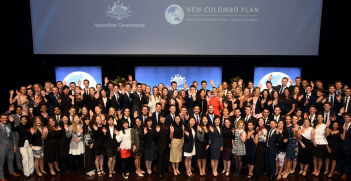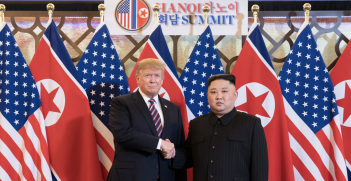Australia Needs a Foreign Policy for its Superannuation Sector

The massive scale and international exposure of Australia’s superannuation industry present new opportunities to leverage retirement savings as a foreign policy tool. However, recent global market volatility highlights significant risks, necessitating clearer government strategies to protect and responsibly manage Australians’ overseas investments.
Within days of President Donald Trump announcing his administration’s (now partially paused) “Liberation Day” tariff regime, Australians had been liberated too—from more than AUD$170 billion of their retirement savings. Trump’s protectionism plunged global markets into freefall, with US stocks seeing their worst day since the start of the COVID-19 pandemic, meaning severe losses for Australian superannuation funds with significant holdings in global markets.
It’s a far cry from late February when a major conference in New York City and Washington D.C. brought together CEOs of Australian superannuation funds with political and business leaders from both sides of the Pacific. Australian treasurer Jim Chalmers addressed the summit, as did two members of the Trump administration’s cabinet, including Treasury Secretary Scott Bessant.
Reflecting the event’s upbeat tone, Chalmers explained the dual economic and foreign policy dimensions of the summit, noting that “Australia’s superannuation sector has the size, scale and presence to play a big role driving new American industries and creating jobs,” but also that the meeting served as a “powerful demonstration of the strategic and economic alignment between our two countries.” Following on, the Australian embassy in Washington D.C. has recently been promoting the investment of “Australian pension funds” in the US.
The summit and the Treasurer’s words are important because they represent the most consequential acknowledgement to date of the foreign policy implications of Australia’s AUD$4 trillion superannuation industry. The sector has more than AUD$1.24 trillion invested overseas, including AUD$400 billion in the US alone.
The Albanese Government has been keen to harness superannuation investments as a foreign policy tool since coming to office, with Indonesia an early focus, then leading to an emphasis on Southeast Asia more broadly as well as India. However, the depth and clarity of foreign policy development on the superannuation industry remains unclear, with the government seeking to use the investment of Australians’ retirement savings in many different contexts and, at times, for inconsistent purposes.
The scale of the sector warrants a sober assessment of its foreign policy risks and opportunities, not least given the losses and volatility seen in recent weeks. In particular, greater clarity is needed on how government should promote, defend, and harness the confluence of public and private interests that these funds represent.
The superannuation industry is growing massive—including its international exposure
Let’s start with the sheer scale of the superannuation industry—especially its largest funds. Compulsory superannuation, instituted in 1992, now guarantees an employer contribution equal to 11.5 percent of individual income towards employees’ retirement savings. The system is a great Australian innovation of social security, ensuring a dignified retirement for current and future generations while reducing the aged pension burden on the budget.
A by-product has been the creation of an enormous financial industry with individual funds commanding significant political and economic influence. Indeed, the IMF, Australia’s Reserve Bank, and financial regulators have all warned that the scale of the industry, and even some individual funds, pose systemic risks to the stability of the Australian economy.
The industry’s assets under management equated to about 137 percent of Australia’s GDP in 2023. It currently stands as the world’s fourth largest pool of retirement savings and is on track to become the second largest by the 2030s, trailing only the US’s own sector. This is a huge, collective national asset for a country globally ranked outside the top fifty in population terms and outside the top ten by GDP.
To generate greater returns and meet the ever-growing retirement needs of Australia’s ageing demographic, superannuation funds are increasingly investing in foreign markets. As Hans van Leeuwen explained, investing overseas is necessary given that the “volume of inflows outgrows the capacity of the Australian domestic market to absorb it.” Between 2019 and 2023, Australian super funds increased their offshore exposure from 41 percent to 47.8 percent of total assets and, over the last decade, funds have more than doubled the value of their international investments. The industry projects it will have more than US$1 trillion invested in the US by the mid-2030s.
Australia’s largest fund, AustralianSuper, is symptomatic of this trend, growing to become a major global investor with offices in New York, London, and Beijing. While AusSuper currently has AUD$340 billion in assets (making it the world’s 18th largest pension fund), this will grow to over AUD$1 trillion over the next decade (equal to 10-12 percent of Australia’s GDP), servicing more than 5 million members. In addition to AUD$85 billion already invested in the US, AusSuper has AUD$40 billion in UK and European assets.
Similarly, Australian Retirement Trust (ART) has over $100 billion invested in the US, while IFM Investors—an investment vehicle owned by 16 of Australia’s largest retirement funds—has had a New York office for almost two decades and has major investments in US infrastructure.
Though the domestic economic implications of this sector are well-acknowledged, there has been relatively little discussion of what it means for Australia—and individual Australians—to have a retirement savings system that is both a major player in, but also heavily dependent on, international markets.
Superannuation funds are a unique type of Australian foreign investor
Superannuation funds constitute a qualitatively different type of Australian investor to most others. As a highly-regulated, compulsory savings scheme with custodianship of the retirement funds of millions of working and retired Australians, superannuation constitutes a quasi-public service.
Australians can choose their superannuation scheme, including its degree of international exposure. However, it is well acknowledged that most individuals are disengaged from actively managing their superannuation, taking a set and forget approach that only exacerbates the information asymmetry that fund managers already hold. While reforms following the banking royal commission have improved the transparency of funds and the portability of member accounts, the cognitive burden to leave and identify an alternative is very high for most people. Perhaps most importantly, though, Australians desiring the greatest returns on their savings will want their funds looking offshore.
So, while a wealthy Melbournian speculating on the S&P 500 or a Sydney company investing in a British firm can be understood as discretionary commercial transactions with full knowledge of the risks, superannuation sees millions of Australians’ finances engaged in foreign markets in ways that they have little awareness of or control over. Arguably, this means the Australian Government owes greater obligations and protections than it might to any other private individual or business putting equity into foreign markets.
At the same time, superannuation funds have unique advantages as investors by virtue of their mandate and the legislated system of guaranteed employer contributions. Funds enjoy certainty about the quantum and rate of inputs over many decades, affording them the “patient capital” to minimise short-term speculation and facilitate long-term investments. This makes the superannuation sector potentially useful for the kinds of strategic investments that the Australian Government has recently sought to catalyse in the Indo-Pacific.
Together these factors—large and politically powerful funds with unique investment capabilities, combined with a massive cohort of financially exposed Australians—mean that government is likely to see greater opportunities but also growing demands fall upon it with respect to international superannuation investments.
Hugh Piper is a director at Ancrum Advisory. He also edits The Policymaker, a digital publication of the James Martin Institute for Public Policy. Hugh has previously worked at the Tony Blair Institute for Global Change, the Asia-Pacific Development, Diplomacy & Defence Dialogue, and as a ministerial speechwriter and strategic policy adviser at the Department of Foreign Affairs & Trade. He holds a master’s degree in public policy from the University of Oxford and degrees in law and history from the University of Sydney.
This article is published under a Creative Commons License and may be republished with attribution.





